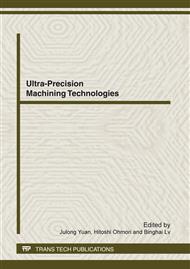[1]
A.L. Owens, A. Peacock: Nuclear instrument and methods in Physics Research Section A Vol. 531 No. 1 (2004), p.18.
Google Scholar
[2]
R.H. Jiang S.Z. Xiao: World Nonferrous Metals No. 8(2002), p.7.
Google Scholar
[3]
C.M. Buttar: Nuclear Insruments and Methods in Physics Research A 395(1997), p.1.
Google Scholar
[4]
N. Parimon, F. Mustafa, A.M. Hashim: Journal of Materials Science and Engineering Vol. 4 No. 6 (2010), p.60.
Google Scholar
[5]
J.B. Chen Y.C. Wang G.Q. Dong: Chinese Journal of Rare Metals Vol. 21 No. 2 (1997), p.44.
Google Scholar
[6]
J.P. Pu, H.J. Zheng, H.J. He, R.Y. Wu: Research & Process of SSE Vol. 17 No. 4 (1997), p.399.
Google Scholar
[7]
Telford Mark Progress in GaAs manufacturing technology[J]. Ⅲ-Ⅴs Review, 2001, 14(6): 22-26.
Google Scholar
[8]
K. Wada: Applied Surface Science, Vol. 85 (1995), p.246.
Google Scholar
[9]
V.C. Venkatesh, I. Inasaki, H.K. Toenshof, et al: Keynote Paper Annals of the CIRP Vol. 44 No. 2(1995), p.611.
Google Scholar
[10]
H.X. Yang. Research of Polished Technology of VB GaAs wafers [D]. Tianjin University (2009).
Google Scholar
[11]
Q. Zhao, H.X. Yang, B.J. Li, F. Lü, Y.L. Liu: Process Technique and Materials Vol. 32 No. 11 (2007), p.964.
Google Scholar
[12]
F. Lü, Y.B. Wang, W.C. Zhang, Y.C. Wu, Q. Zhao: Techmology Column Vol. 34 No. 8 (2001), p.745.
Google Scholar
[13]
H.X. Yang, F. Lü, Q. Zhao, C.X. Liu: Semiconductor Information Vol. 38 No. 5 (2001), p.55.
Google Scholar
[14]
H.X. Yang, F. Lü, Q. Zhao, C.X. Liu: Journal of CAEIT Vol. 2 No. 5 (2007), p.527.
Google Scholar
[15]
F. Zhang, A. AHMED, G. AHMADI, et al: Journal of the Electrochemical Society Vol. 10 (1999), p.2.
Google Scholar
[16]
Y. Chen, X.Z. Li, Z.G. Chen, A.L. Chen: Research & Progress OFSSE RESEARCH﹠PROGRESS OFSSE Vol. 26 No. 4 (2006), p.555.
Google Scholar
[17]
X. Lü, W. Yu: Lubrication Engineering Vol. 34 No. 4 (2009), p.74.
Google Scholar
[18]
V.K. SHAHA: Development of a new generation polyurethane polishing pad used in chemical mechanical planarization of microelectronic materials[D]. USA, University of Massachusettles Lowell (2002).
Google Scholar


